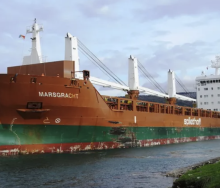Ocean freight rates could fall 70% in the second half (H2) of 2025, heralding one of the biggest drops in containerisation’s history, ocean trade platform Linerlytica reports.
However, peer platform Xeneta says for such a decrease to occur, maritime trade through the Suez Canal would have to be restored to levels seen prior to the plunge caused by Yemen’s Houthi rebels attacking commercial vessels in the important waterway.
According to Linerlytica, the projected drop in rates over the next 12 months is based on carriers failing to prevent the slide in rates seen since July, as per statistics from the Shanghai Container Freight Index (SCFI).
Lines have failed to stem this slide since the July peak, exacerbated by waning demand and the delivery of 36 ships capable of just under 205 000 TEUs, adding to what appears like an over-capacity situation that’s in free fall.
Furthermore, writes Mary Ann Evans in Container News, freight futures are continuing to weaken, with rates in North Europe trading at a discount of over 70% compared with current spot rates, Linerlytica has found.
The global container shipping market could see its long-term contract rates significantly impacted.
Rates are expected to drop by over 70% by June of the following year, based on the latest CoFIF EC contracts traded on the Shanghai International Energy Exchange.
Although this decline may not be as sharp as the freight rate collapse at the end of 2022, the current freight futures prices suggest a continued decline over the next 12 months, with no rebound anticipated at the end of this year and no repetition of this year’s post-Chinese New Year rate rally in 2025.
The consultancy notes that shipping lines have been unable to maintain spot rate levels, with the SCFIS falling by 12% on the North European trades since July.
There has been a steady 1-3% weekly decline, culminating in a 7.3% drop last week.
The SCFIS, which is considered a more accurate measure of actual market spot rates, has been in decline since the July highs on the Pacific to the US West Coast.
In contrast, the SCFI provided a misleading indication of a rate rebound a week ago, amidst losses of 38% since July.
The SCFIS tracks rates for exports from Shanghai to four major European ports and three US West Coast ports, whereas the SCFI covers a broader global range of trades from Shanghai.
The SCFI has also seen rates deteriorate by 5.6% over the past week on the Pacific and Middle East trades.
Xeneta’s chief analyst, Peter Sand, believes that a 70% fall in contract rates is contingent on resolving the Red Sea crisis and restoring vessel traffic via the Suez Canal.
He acknowledges the possibility of rates finding a new level but highlights that the Red Sea situation is significantly different from the previous year, when rates were declining and shipping lines were reporting losses.
Sand notes that although volumes are up, they are comparable to those in 2021 and 2022, indicating that this is not a demand-driven market.
Xeneta’s CTS (Container Trades Statistics) data shows that total volumes, including dry and reefer, increased by 6.5% in the first half of 2024 compared with 2019, rising from 84.1 million TEUs in H1 2019 to 89.6 million TEUs.
During the same period, the fleet has grown by 30.8%, reaching 29.569 million TEUs by the end of H1 2024, up from 22.603 million TEUs in mid-2019, as reported by Sand using data from Xeneta and Clarksons.
Sand said the longer sailing distances round South Africa due to the Red Sea disruption had significantly altered market dynamics, shifting from massive overcapacity to a tighter market.
Xeneta estimates that TEU miles in the first four months of 2024 have increased by 18.3% year-on-year, effectively closing the gap between demand and supply, as evidenced by the current high contract and spot freight rate levels.













